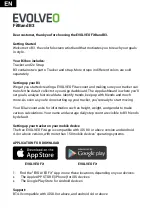
14
Chapter 1 Introduction
1-3.
Controls and Functions
4
3
14
15
2
1
12
9
11
6
16
7
10
13
5
8
Approx. 30°
1. Integrated Front Sensor
(Movable)
This sensor is used to perform calibration and Grayscale Check.
2. Ambient Light Sensor
This sensor measures environmental illumination. Environmental illuminance
measurement is performed using the RadiCS / RadiCS LE quality control software.
3.
Operation switches
Displays the operation guide. Set menus according to the operation guide.
4.
switch
Turns the power on or off.
The switch indicator is lit when you turn the power on. The indicator color differs
depending on the monitor's operation status.
Green: Normal operation mode, Orange: Power-saving mode, Off: Main power /
power turned off
5.
Handle
The handle is used for transportation.
Attention
• Firmly grasp and hold the monitor by the bottom while grabbing the handle, and
carefully transport the monitor so as not to drop it. Do not hold the sensor section
on the front side of the monitor.
6.
Stand
Adjusts the height and angle (tilt and swivel) of the monitor.
7.
USB Type-C connector
(quick charge only)
Connect it to a USB device.
Attention
• Does not support data communication.
8.
USB Type-A connector
(USB downstream port)
Connect it to a USB device. To set up a daisy-chain connection, connect the cable to
the USB upstream port of another monitor.
9.
Main power switch
Turns the main power on or off.
: Off,
: On
10. Security lock slot
Complies with Kensington’s MicroSaver security system.
11.
Cable holder
Holds the monitor cables.
12.
USB Type-B connector
(USB upstream port)
Connect this port to the PC when you use software that needs a USB connection or
connect a USB device (peripheral device that supports USB) to the USB downstream
port.
13.
DVI-D connector
Connect it to the PC.
14.
DisplayPort input
connector
15.
DisplayPort output
connector
To set up a daisy-chain connection, connect the cable to the DisplayPort input
connector of another monitor.
16.
Power connector
Connects the power cord.















































